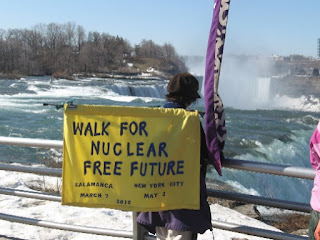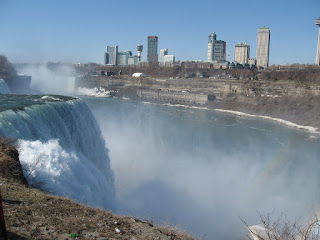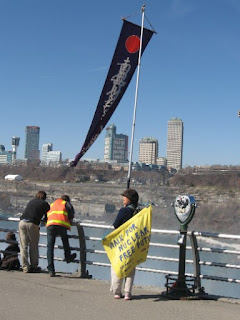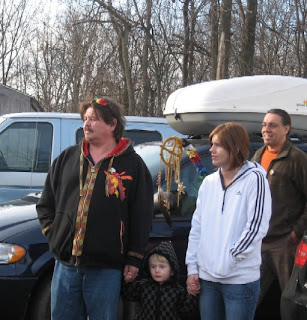Here is the story from day two of my walk with the Walk for a Nuclear-Free Future (northern route):
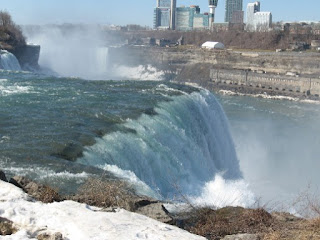
We got to explore Niagara Falls on March 17th! It was another beautiful day for a walk. We walked from the corner of 84th Street and Buffalo Avenue, Niagara Falls, to the Tuscarora Nation in Lewiston. It was a very long walk, but the places were very significant. On Buffalo Avenue, we walked through an old industrial section. There had been many chemical plants in that area, which had produced a great deal of toxic waste. Much of that waste ended up in the Niagara River. There is still some functioning industry along Buffalo Avenue but I hope that they clean up the waste in a safer way than was done in the past.
Niagara Falls is well known for toxic waste. One of the neighborhoods in Niagara Falls, Love Canal, was built on land that had been a burial site for some really dangerous toxic waste, including dioxin and benzene. The business that had buried the waste was Hooker Chemical. In the late 1970s, it was discovered that people who lived in Love Canal were suffering from various forms of cancer at an unusually high rate. The toxic waste had leached from the drums that were supposed to contain it into the soil and the ground water. Eventually, due to the efforts and Lois Gibbs and the Love Canal Homeowners Association, the residents were evacuated from that area. It was considered to be a great tragedy. The houses in the Love Canal neighborhood were built to be the dream homes for the young families who moved there. But when the children began suffering from leukemia, the dream turned into a horrifying nightmare for those families.
After we left the industrial area of Niagara Falls, located along the Niagara River, we saw downtown Niagara Falls and we also stopped to look at the Falls, one of the seven natural wonders of the world. And a wonder it is. There are always rainbows directly above the falls. We saw some ice and snow still on the ground and the water, despite the warmth of the air and the brilliance of the sunshine.
We then walked along the general area of the gorge, which is a fault line, although, fortunately, a very stable one so earthquakes in Niagara Falls are very unlikely occurrences. We had our lunch at Whirlpool State Park and we saw the very blue water of the whirlpool that is another part of Niagara Falls.
Before long, we were out of Niagara Falls and in the Town of Lewiston. We walked through Niagara University and started heading east. We walked and walked and walked…
When we arrived at the edge of the Tuscarora Nation, we were welcomed by Chief Stuart Patterson. We continued walking well into Tuscarora territory and finally arrived at our destination at about six o’clock in the evening. We were welcomed with a traditional ceremony and were treated to a delicious potluck dinner. As we had walked for about twenty miles, we were very hungry and footsore. We were shown a video about boarding schools for Indian children that were run by various entities, such as the federal government, states, and religious missions from about the late nineteenth century to the 1950s.
The first Indian boarding school was the Carlisle Indian Industrial School, which was founded by Richard Henry Pratt in 1879 at a deserted military base (the Carlisle Barracks) in central Pennsylvania. Pratt’s goal was to destroy indigenous culture in North America. He said, “Kill the Indian, save the man.” Pratt had a military background; he had served in the Tenth Cavalry from 1867 until 1875 and was stationed in the Indian territories. Thus he created the school according to the model that he knew best, which was the military model.
Other schools were founded in different areas, based on the Carlisle Indian Industrial School model. Children who were sent to these schools were taken away from their families and were forbidden to speak their native languages or to learn about their own cultures. They were forcibly assimilated into American culture. As an example, a barber was brought to the Carlisle Indian Industrial School to cut the children’s long hair. This caused much distress among the children. According to an article titled Carlisle Indian Industrial School History, “For the Lakota, the cutting of hair was symbolic of mourning and there was much wailing and lamenting which lasted into the night.”
In Western New York, many children were sent to the Thomas Indian School in Irving, New York. The children spent more time working as free labor than they spent studying. Children worked hard. They had to clean the school constantly. Also, many of the schools had adjoining farms. The children worked hard in the fields. They did not enjoy the results of their labor. For example, children at a school with lots of chickens never got to eat any of the eggs that the chickens laid.
At the Mush Hole School in Canada, the children were so hungry that they foraged through garbage dumps for food.
Children at the Indian schools also suffered from all types of abuse, including emotional, physical, and sexual abuse. When they complained of being abused or even of being raped, no one believed them. Many tried to run away, as they were very desperate to return to their homes and their families, to places where they could speak their own languages.
Many of the children did not survive the experience.
It was truly a very sad and shocking story about the effort of many people to destroy indigenous cultures in North America.
Canada issued an apology a few years ago for the cruelty that occurred at the school. At the time, there were pending lawsuits, which Canada settled. Survivors of the schools were able to collect some money as a result of the settlement of the lawsuits.
The United States has never apologized for this very dark period in its history, when it basically declared war on children.
In addition to learning about the Indian boarding schools, which have since been closed, we also learned about the effect of waste from the Manhattan Project on the Tuscarora nation. A great deal of radioactive waste had been buried by the U.S. government in Lewiston during the 1940s. Some radioactive waste has been found in the Niagara River. The result of all of this exposure to radioactive waste is an increase in the rates of various types of cancer.
Japanese people who had survived the atomic bombings of Hiroshima and Nagasaki were called hibakusha. People in Lewiston and other parts of Western New York, who were exposed to the radioactive waste created by the Manhattan Project, can also be called hibakusha. I know of one woman, Rita, who died of lung cancer. My mom knew Rita because the her husband worked with my mother at Niagara University. Rita never smoked. The cancer that killed her was a cancer of the lining of the lungs. It was not the kind of cancer that smokers are prone to develop. It is very possible that prolonged exposure to radioactive waste caused Rita’s cancer.
These atomic bombs can be said to have continued to kill years after they were detonated.
